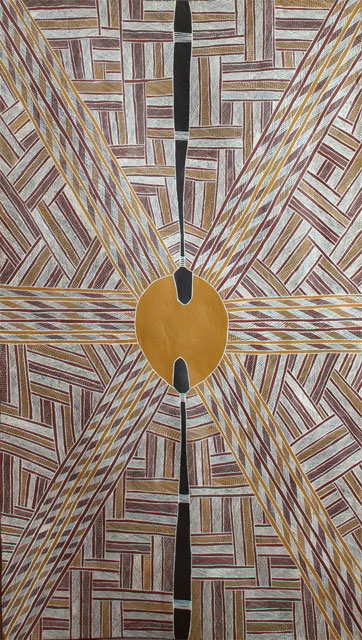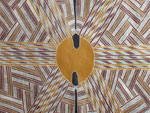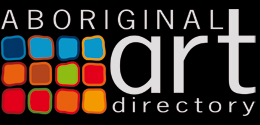Banduk Marika
Paddles on the beach at Yalangbara
65
votes


Banduk Marika
Paddles on the beach at Yalangbara
Medium: Natural ochre pigments on bark
Size: 124x71cm
Price: $ NFS
NFS
The songs which found this paintings meaning start after the Dja\’kawu Sisters have arrived from their mythical Atlantis-like island Burralku. They arrived in North-East Arnhem land at sunrise. Indeed, the name given to this part of Australia is Miwatj or Morning Side referring to the fact that this is the first part of the Top End to see the morning sun.
Matalatj (the elder sister who gives birth later in the story) and Bitjiwurrurru (her younger sister who acts as midwife) have just paddled their canoe a long way and then climbed the sand dunes to where they stop for a rest as the sun rises (top of the painting). The suns rays strike the Buwarta (English name Bustard ) and reflect off the water. As this happens the Sisters sing Buwarta and name it. They do the same as the sun strikes two other important Dhuwa birds related to the Rirratjingu clan, Lindirritj (rainbow lorikeet left) and |atili (black cockatoo right).
The Sisters put their paddles down and it turned into the sacred djuta tree from which they hung their ceremonial bathi or sacred dili bags. Gowudalbudal (the male shining flycatcher) who sings the tide coming in or going out sat on one of those trees.
The painting is a representation of the sacred spring or Mil\urr that the Sisters found that morning. To Dhuwa people this motif represents knowledge. The lines leading to the centre of the waterhole shows the sisters walking tracks to and then from the spring in their various forms as brolga and goanna at different stages of the journey.
What makes this work unique is the incorporation of the sister’s paddles into the design. The sisters name Gudurrku (Brolga) and Baripari (Sacred Ibis). The sun still rises as goannas drink from Mil\urr and |atili hears the crashing of the waves and sees the foam created by the meeting of fresh and salt water.
Mangirrikirri the fruitbats are haloed by the rising sun. The Sisters prepare for the first birth, a self- fertilised act of creation. Their white hair, Djawulu, is symbolic of sacred wisdom and is one of the names this artist is known by. His other name, Mawalan, is the name given to the sacred staff the Sisters use to create springs and rocks and other features in their later journeys through the land of other Dhuwa clans.
The sun has risen on the birth of a nation; the Rirratjingu clan. Banduk's brother Wandjuk included a version of this image as a segment of his Yirrkala Church Panels contribution (1962-3).
The Art Lover's Vote
Vote for this artwork and share it with other Aboriginal art devotees!
65
votes
Further Research
Tags: Banduk Marika | bark painting
Similar artworks: Djanda | Water Design | Yalaara | Fishtrap | Marrakulu Land |
Selected News Archive hosted by News Aboriginal Art Directory
- 05.10.14 | ABORIGINAL LANGUAGES
- 04.07.14 | RED OCHRE FOR HECTOR BURTON
- 25.11.13 | Cultural Connection, Art and the Value of Life



